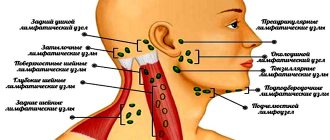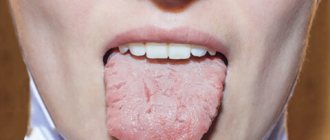It happens that unpleasant inflammations appear on the tongue, causing discomfort and pain. This happens often; almost every person has encountered this phenomenon at least once in their life.
Typically, the papillae on the tongue become inflamed due to external factors, and are characterized by their transience. But it happens that such a reaction of the tongue mucosa is provoked by internal factors, and is a symptom of a serious disease.
This article will tell you how to figure out what problem the patient is dealing with and help the tongue papillae return to normal as quickly as possible.
Causes of inflammation of the papillae on the tongue
Conventionally, the reasons that caused inflammation of the papillae of the tongue can be divided into 2 groups:
- The mucous membrane of the tongue can be damaged by gastric juice
mechanical (obtained as a result of mechanical action on the tissues of the tongue);
- internal (when inflammation of the receptors occurred as a result of diseases caused by pathogenic microorganisms and their metabolic products).
Mechanical reasons include:
- burns from chemical compounds (acids, alkalis, alcohols);
- burns from thermal effects (excessively hot food or drinks);
- the mucous membrane is damaged by gastric juice (most often this occurs during vomiting or reflux esophagitis, when gastric juice with food particles is thrown into the esophagus; gastric juice has a very acidic environment, which causes a chemical burn);
- mechanical damage from direct contact with an irritating object (for example, when sucking candy or from constantly eating food with a rough surface);
- household injuries, including damage to tongue tissue from hygiene items or accidental biting;
- when brushing your teeth aggressively: the bristles of the toothbrush injure the mucous membrane of the tongue;
- regular injuries resulting from sharp chipped teeth, unsuccessfully placed dentures or fillings;
- too spicy or salty food;
- stress and depression as factors that weaken the body's immune system.
Other reasons include:
- Language structure
diseases localized in the oral cavity (and caused by fungi, various bacteria and some types of viruses, including the herpes virus);
- allergies;
- uncontrolled or very long-term use of antibiotics;
- such systemic diseases as: scarlet fever, measles, diphtheria, anemia, disruptions in the gastrointestinal tract;
- avitaminosis;
- decreased immunity.
Important! It is necessary to distinguish between such types of inflammation of the papillae as papillitis and glossitis. Papillitis occurs as a consequence of mechanical damage, and glossitis - as a consequence of pathogenic processes.
Symptoms
The patient may experience discomfort in communication due to impaired diction and thickening of the upper layer of the epithelium of the tongue
The main symptoms of inflammation of the papillae on the tongue are their redness (hyperemia) and soreness (or itching).
There are also disruptions in the perception of the taste qualities of food and drinks and their temperature conditions.
As a result of inflammation, the patient may experience discomfort in communication due to impaired diction and thickening of the upper layer of the epithelium of the tongue.
You can distinguish papillitis from glossitis by looking at the back of the tongue: if there is no plaque on it, this means the inflammation is non-infectious.
Also, the symptoms of papillitis tend to disappear within a few days without medical assistance, since a feature of the mucous membrane of the tongue is its rapid recovery.
Sometimes an infection is associated with papillitis, but this is considered a complication and goes into the category of glossitis.
External manifestations
If you look closely at the painful area, the inflamed papillae can be easily identified. They increase in size and change color, becoming soft pink, deep red or completely white (with candidiasis).
Thread-like stretched along the edges of the tongue. Their number is greatest, their function is to touch and hold food in the mouth, they do not perceive taste
Localization
An important role in making a diagnosis and finding out the cause of the disease is its localization. The localizations of inflammation of the papillae, as well as the possible causes of their appearance, will be listed below.
In all languages
Inflammation of the papillae throughout the tongue may indicate a chemical or thermal burn, as well as the infectious nature of the disease.
Inflammation of the papillae throughout the tongue may indicate a chemical or thermal burn
On the root
If the problem area is the back of the tongue (root), then the patient will experience difficulty perceiving the bitter taste, since the inflammation will affect the grooved papillae responsible for this.
A popular cause of this localization of inflammation is an allergic reaction, with the patient noting increased salivation and swelling of the tissues, including the soft palate that may react with swelling.
The cause may be diseases associated with the gastrointestinal tract, or malfunctions in its functioning (for example, too low or high acidity). Also, it is on the root that fungal and bacterial glossitis is localized.
The cause may be diseases associated with the gastrointestinal tract or malfunctions in its functioning.
On the tip
The tip of the tongue most often suffers from mechanical damage, since the tip comes into contact with too hot food and drinks, rubs against chipped teeth, and is subjected to biting.
The tip of the tongue most often suffers from mechanical damage, since the tip comes into contact with food and drinks that are too hot
Side
On the sides of the tongue there are the so-called conical, mushroom-, filament- and leaf-like structures of the tongue.
Enlargement and hyperemia of the taste buds, which are located on the sides of the tongue, most often appear due to mechanical damage to the teeth, but pathogenic microorganisms and chemical burns can also be the cause.
Inflammation on the sides of the tongue can also be caused by pathogenic microorganisms and chemical burns.
Is it worth treating glossitis with folk remedies?
If you have a question: how to cure glossitis, don’t waste time looking for folk remedies! If you notice characteristic symptoms that do not go away for more than a day, you need to seek help from a specialist. Treatment of glossitis should be carried out only by a dentist, who will determine the cause of the changes in the oral cavity, carry out all the necessary therapeutic and diagnostic procedures, prescribe a set of therapeutic measures that the patient can perform at home, and also monitor the entire treatment process, making changes to it as needed. necessary adjustments. Moscow dental clinics are presented in the “Search” section on our website.
Glossitis, like other periodontal diseases, is fraught with many complications, so treatment with folk remedies can only serve as an aid in complex therapy.
In order not to come face to face with glossitis, it is enough to brush your teeth regularly, including brushing your tongue, and do not skip preventive examinations at the dentist. In addition, doctors recommend avoiding excessive consumption of spicy foods and spices, limiting the intake of alcoholic beverages and smoking. Remember, disease is easier to prevent than to treat.
Diagnostics
If the patient has inflamed papillae on the tongue and the symptoms do not go away within a day or two, if the symptoms worsen, if they are pronounced, and the points of inflammation themselves are very painful, then you need to consult a dentist.
The dentist will conduct an examination on the following points:
- If the presumptive diagnosis is associated with diseases of the internal organs, then additional consultation with other specialists will be required.
assess the color, shape and size of problem areas;
- determine whether there is swelling;
- check the tongue for mechanical tissue damage;
- examine the surface of the tongue for plaque; if it is detected, it will evaluate its location, color and quantity;
- check the tongue for the presence of ulcers or eczema;
- Assess the condition of the oral cavity as a whole.
The following tests may be required to make a diagnosis:
- Smear for histology;
- Tongue sensitivity testing;
- Blood sampling for general analysis and biochemistry;
- Blood test to exclude HIV, AIDS, hepatitis virus, syphilis and other pathogenic elements.
If the presumptive diagnosis is associated with diseases of the internal organs, then additional consultation with other specialists (gastroenterologist, dermatologist, endocrinologist, immunologist, ENT) will be required.
Surface structure
If cracks have formed on the surface of the tongue, this usually indicates dehydration and excessive blood thickening, which, in turn, increases the risk of stroke or thrombosis. Also, a dry surface with numerous small cracks is one of the symptoms of diabetes. But depending on their location, cracks can indicate different diseases. For example, one deep one in the middle of the tongue can be a symptom of an upset digestive system and high acidity in the stomach.
A spotted or raised tongue may indicate that a person has fungal infections, vitamin deficiency or allergies.
Sometimes such changes appear in people with vitiligo or psoriasis. But if a curved line is clearly visible on the surface, then the musculoskeletal system should be checked; this may be a signal of a spinal disease.
Treatment
If after a couple of days the symptoms have not disappeared or, on the contrary, have intensified, rush to the dentist
If the papillae are inflamed, but the cause is difficult to determine, then first of all, rinse your mouth with an antiseptic solution.
If after a couple of days the symptoms do not disappear or, on the contrary, intensify, rush to the dentist.
After conducting the diagnostics, he will make a diagnosis and either refer you to another doctor or describe how to treat the problem.
Typically, treatment consists of antiviral (acyclavir, Zovirax) and antihistamine (suprastin, tavegil) drugs, antibiotics (clorsacillin, clindomycin) and antifungal agents (chlorhexidine, furacelin, miramistin).
If you can’t see a doctor, you can improve your condition at home.
The following methods are effectively used for this:
- You can apply ice (or chew it) to relieve swelling.
- Regularly rinse your mouth with a baking soda solution (15 grams of baking soda per 1 glass of lukewarm water) - this will help relieve inflammation and reduce swelling.
- Lubricate the problem area with honey - this product is famous for its antibacterial properties, and it will also help relieve swelling and promote tissue regeneration.
- Drink natural yogurt - it will help restore normal oral microflora if the problem lies in its disturbances.
Development of pathology
The most complex forms of progressive inflammation of the gingival papillae are gingivitis and periodontitis. The most common in dental practice is catarrhal gingivitis, which has symptoms similar to advanced inflammation and can lead to changes in the shape of the gums and deterioration of health on an ongoing basis.
Ulcerative gingivitis is a pathology that provokes the death of gum tissue and inflammatory processes in the lymph nodes. One of the reasons for its occurrence is hypothermia of the oral cavity, in combination with bacteria leading to the formation of gray plaque on tissue areas. Treatment of the disease must begin in the early stages, otherwise it can develop into severe purulent inflammation.
Hypertrophic gingivitis is characterized by accelerated growth rates of cellular tissues of the basal and connective group. The cause is a disruption of hormonal levels and normal metabolism in the body. In the absence of therapy, thickened tissues begin to keratinize and thicken, causing pain and discomfort.
Periodontitis is the formation of a temporary cyst in the upper area of a tooth susceptible to pathology. Purulent accumulations form in the cavity, causing swelling and pain. The process can be caused not only by bacteria, but also by pulpitis, as well as by an incorrectly performed dental prosthetic procedure.
Features of child treatment
Even with papillitis, you can catch a serious complication
If a child complains of pain in the tongue, and you notice redness of the papillae, brush the baby’s teeth, ask him to rinse his mouth thoroughly, and go to the dentist.
The child’s immune system is not yet strong enough to cope with inflammation on its own.
Even with papillitis, you can catch a serious complication, since a curious child explores most objects from the surrounding world using the oral cavity.











